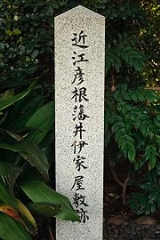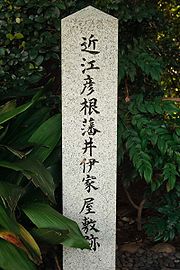
Hikone Domain
Encyclopedia
The was a feudal domain of Japan
during the Edo period
. It was established in 1600 with Ii Naomasa
as the first daimyo
. All fifteen daimyo were from the Ii clan
.
A large fudai
domain, Hikone was initially rated at 180,000 koku
. The rating reached a peak of 300,000 (with the status of a 350,000 koku domain), and in 1871, when the domain was abolished, it was 200,000 koku.
The domain initially had its headquarters at Sawayama
, the castle that had been occupied by Ishida Mitsunari
prior to the Battle of Sekigahara
. Construction of the new castle at Hikone
began in 1603.

Japan
Japan is an island nation in East Asia. Located in the Pacific Ocean, it lies to the east of the Sea of Japan, China, North Korea, South Korea and Russia, stretching from the Sea of Okhotsk in the north to the East China Sea and Taiwan in the south...
during the Edo period
Edo period
The , or , is a division of Japanese history which was ruled by the shoguns of the Tokugawa family, running from 1603 to 1868. The political entity of this period was the Tokugawa shogunate....
. It was established in 1600 with Ii Naomasa
Ii Naomasa
was a general under the Sengoku period Daimyo, and later Shogun, Tokugawa Ieyasu. He is regarded as one of the Four Guardians of the Tokugawa along with Honda Tadakatsu, Sakakibara Yasumasa and Sakai Tadatsugu.-Early life:...
as the first daimyo
Daimyo
is a generic term referring to the powerful territorial lords in pre-modern Japan who ruled most of the country from their vast, hereditary land holdings...
. All fifteen daimyo were from the Ii clan
Ii clan
The ' is a Japanese clan which originates in Tōtōmi Province. It was a retainer clan of the Imagawa family, and then switched sides to the Matsudaira clan of Mikawa Province. A famed 16th century clan member, Ii Naomasa, served as one of Tokugawa Ieyasu's generals, and received the fief of Hikone...
.
A large fudai
Fudai
was a class of daimyo who were hereditary vassals of the Tokugawa in Edo period Japan. It was primarily the fudai who filled the ranks of the Tokugawa administration.-Origins:...
domain, Hikone was initially rated at 180,000 koku
Koku
The is a Japanese unit of volume, equal to ten cubic shaku. In this definition, 3.5937 koku equal one cubic metre, i.e. 1 koku is approximately 278.3 litres. The koku was originally defined as a quantity of rice, historically defined as enough rice to feed one person for one year...
. The rating reached a peak of 300,000 (with the status of a 350,000 koku domain), and in 1871, when the domain was abolished, it was 200,000 koku.
The domain initially had its headquarters at Sawayama
Sawayama Castle
is a castle in the city of Hikone, Shiga Prefecture, Japan. This castle was an important military stronghold of Ōmi Province. The Azai clan held this castle in the Sengoku Period. Ishida Mitsunari held it at the end of the 16th century after the ruin of the Azai clan.This castle was attacked by...
, the castle that had been occupied by Ishida Mitsunari
Ishida Mitsunari
Ishida Mitsunari was a samurai who led the Western army in the Battle of Sekigahara following the Azuchi-Momoyama period of the 17th century. Also known by his court title, Jibunoshō...
prior to the Battle of Sekigahara
Battle of Sekigahara
The , popularly known as the , was a decisive battle on October 21, 1600 which cleared the path to the Shogunate for Tokugawa Ieyasu...
. Construction of the new castle at Hikone
Hikone Castle
is the most famous historical site in Hikone, Shiga Prefecture, Japan. This Edo period castle traces its origin to 1603 when Ii Naokatsu, son of the former daimyo Ii Naomasa, ordered its construction. The keep was originally built in 1575, as part of Ōtsu Castle, and was moved to Hikone by the Ii...
began in 1603.
List of Daimyo

- Ii clanIi clanThe ' is a Japanese clan which originates in Tōtōmi Province. It was a retainer clan of the Imagawa family, and then switched sides to the Matsudaira clan of Mikawa Province. A famed 16th century clan member, Ii Naomasa, served as one of Tokugawa Ieyasu's generals, and received the fief of Hikone...
, 1600-1871 (FudaiFudaiwas a class of daimyo who were hereditary vassals of the Tokugawa in Edo period Japan. It was primarily the fudai who filled the ranks of the Tokugawa administration.-Origins:...
; 180,000->150,000->200,000->250,000->300,000->200,000 kokuKokuThe is a Japanese unit of volume, equal to ten cubic shaku. In this definition, 3.5937 koku equal one cubic metre, i.e. 1 koku is approximately 278.3 litres. The koku was originally defined as a quantity of rice, historically defined as enough rice to feed one person for one year...
)
- NaomasaIi Naomasawas a general under the Sengoku period Daimyo, and later Shogun, Tokugawa Ieyasu. He is regarded as one of the Four Guardians of the Tokugawa along with Honda Tadakatsu, Sakakibara Yasumasa and Sakai Tadatsugu.-Early life:...
- NaokatsuIi Naokatsuwas a Japanese daimyo of the Edo period who served the Tokugawa clan. He was also known as Ii Naotsugu. Naokatsu succeeded to family headship following his father's death in 1602. Under Tokugawa Ieyasu's orders, Naokatsu completed construction of Hikone Castle in 1606, and then moved there from...
- NaotakaIi Naotakawas a Japanese daimyo of the early Edo period who served under the Tokugawa shogunate. He was the son of the famous Tokugawa general Ii Naomasa.Naotaka served in the Siege of Osaka in his brother Naokatsu's stead, where he would gain tremendous favor for his exploits at Tennoji. After the battle,...
- Naozumi (Served as TairōTairoTairō was a high-ranking official position in the bakuhan taisei government of Japan. The tairō would preside over the governing Rōjū council in the event of an emergency. A tairō would be nominated from among a group of samurai families who supported Tokugawa Ieyasu...
) - Naooki (Served as TairōTairoTairō was a high-ranking official position in the bakuhan taisei government of Japan. The tairō would preside over the governing Rōjū council in the event of an emergency. A tairō would be nominated from among a group of samurai families who supported Tokugawa Ieyasu...
) - Naomichi
- Naotsune
- Naoharu (later changed name to Naomori; served as TairōTairoTairō was a high-ranking official position in the bakuhan taisei government of Japan. The tairō would preside over the governing Rōjū council in the event of an emergency. A tairō would be nominated from among a group of samurai families who supported Tokugawa Ieyasu...
) - Naonobu
- Naosada
- Naoyoshi
- Naosada (2nd time)
- Naohide (Served as TairōTairoTairō was a high-ranking official position in the bakuhan taisei government of Japan. The tairō would preside over the governing Rōjū council in the event of an emergency. A tairō would be nominated from among a group of samurai families who supported Tokugawa Ieyasu...
) - Naonaka
- Naoaki
- NaosukeIi Naosukewas daimyo of Hikone and also Tairō of Tokugawa Shogunate, Japan, a position he held from April 23, 1858 until his death on March 24, 1860. He is most famous for signing the Harris Treaty with the United States, granting access to ports for trade to American merchants and seamen and...
(Served as TairōTairoTairō was a high-ranking official position in the bakuhan taisei government of Japan. The tairō would preside over the governing Rōjū council in the event of an emergency. A tairō would be nominated from among a group of samurai families who supported Tokugawa Ieyasu...
) - NaonoriIi NaonoriCount was a Japanese daimyo of the late Edo period, who ruled the Hikone Domain. He was the second son of Ii Naosuke. After he was relieved of office in 1871, he studied in the United States and England. He was created count in the Meiji period.-References:...
Further reading
- Bolitho, HaroldHarold BolithoHarold Bolitho was an Australian academic, historian, author and professor emeritus in the Department of East Asian Languages and Civilizations at Harvard University The name Bolitho is of Cornish origin.-Career:...
. (1974). Treasures Among Men: The Fudai Daimyo in Tokugawa Japan. New Haven: Yale University Press. 10-ISBN 0-300-01655-7/13-ISBN 978-0-300-01655-0; OCLC 185685588

